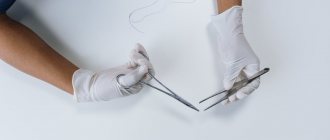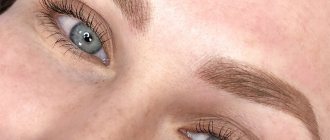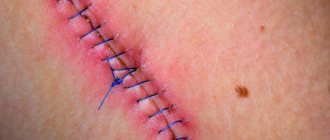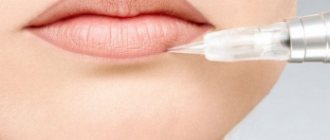"Levomekol" is an antibacterial combination drug for external use with a wide spectrum of action. Levomekol ointment prevents the spread of pathogenic microbes, eliminates swelling, accelerates wound healing, and also increases local skin immunity.
Levomekol for burns
This combination is provided by two active components in the ointment - Chloramphenicol (aka Levomycetin) and Methyluracil. Chloramphenicol is a natural antibiotic that actively blocks intestinal, pseudomonas and staphylococcal bacilli. And methyluracil accelerates the regeneration of the epidermis. The peculiarity of methyluracil is its ability to easily and quickly penetrate into the dermis, without affecting the membrane cell membrane. This process is associated with the removal of excess fluid from the intercellular space, which usually causes swelling and bruising.
What is Levomekol used for?
Levomekol has a multifaceted therapeutic effect:
- quickly reduces the inflammatory process, prevents its spread to healthy tissues;
- prevents the growth and reproduction of bacterial infectious agents;
- quickly eliminates swelling by normalizing microcirculation;
- ensures delivery of nutrients and biologically active substances, as well as molecular oxygen, to the affected tissues;
- stimulates the regeneration of inflammatory cells of all layers of the epidermis;
- increases immunity at the local level.
The ointment quickly removes all inflammatory processes on the skin
It is worth noting that the presence of purulent discharge and necrotic tissue does not prevent Levomekol ointment from performing its function. The drug can be used to disinfect and accelerate tissue regeneration.
Levomekol, ointment for external use, 40 g, 1 pc.
STADA, Russia
Price from 126₽
There are contraindications. Specialist consultation is required.
Action and components
The use of this drug began in the 20th century, in the 70s. The effectiveness of treatment with Levomekol can be explained by the fact that it contains:
- Methyluracil. This component is an immunostimulant. Thanks to it, metabolism is normalized in areas of cellular damage, the ability of the epidermis to regenerate increases and the production of interferon begins, which helps to increase the protective properties of the skin.
- Chloramphenicol. This antibiotic is capable of destroying a wide range of pathogenic microflora. The component has a detrimental effect on Escherichia coli and Pseudomonas aeruginosa, as well as staphylococci.
If you treat burns with this ointment, the healing and scarring of the wound will go much faster. In addition, the drug does not allow bacteria to multiply and relieves the inflammatory process.
Using Levomekol ointment for burn injuries will not harm the biological membranes of skin cells. Its therapeutic properties do not change even if there is pus in the wound. Thanks to this, the drug can be used even if a person has a third or fourth degree injury (see 4th degree burn).
Levomekol is intended for external use. All its components are absolutely safe, so it can be applied even to the skin of a newborn baby. After using the drug, pathogenic microorganisms continue to die for 20 hours.
Indications for use of Levomekol ointment
Since Levomekol ointment has an antibacterial effect, and at the same time stimulates the restoration of tissue structure, the drug is indicated for the following diseases:
- infection of wounds with pathogenic microflora, ulcers and purulent abscesses on the epidermis;
- burns (mostly 2nd and 3rd degree);
- violation of tissue integrity due to injuries;
- necrotic processes;
- weeping and dry eczema;
- calluses;
- trophic ulcers;
- frostbite of the extremities (superficial layers of the skin);
- pimples, acne, carbuncles, boils;
- otitis and sinusitis (including with purulent discharge);
- treatment of sutures after surgery
- bedsores;
- haemorrhoids.
Levomekol ointment can be used for children
"Levomekol" can be used for children from 1 year. But before this, it is imperative to consult a pediatrician.
Contraindications
Like many drugs, Levomekol has contraindications:
- individual intolerance to the components of the medication;
- hypersensitivity of the body;
- fungal infections of the epidermis;
- tendency to allergic reactions;
- psoriasis.
The official instructions for use indicate that in pediatrics the ointment is prescribed starting from 3 years of age. However, many pediatricians, based on the harmlessness of Levomekol, allow its use from infancy.
Side effects
Levomekol is considered a universal drug and is usually well tolerated by patients. But in case of overdose (if the drug is used for more than a week), allergic skin reactions may occur.
- hyperemia;
- burning;
- itching;
- urticaria;
- dermatitis at the site of application;
- local swelling;
- When using vaginal tampons, candidiasis may occur.
No incompatibility with other medicinal products has been reported. Make sure that the ointment does not get into your eyes, mucous membranes or inside. In case of contact with eyes and mucous membranes, rinse them immediately with running water. If swallowed, the stomach must be rinsed.
Levomekol in the treatment of burns
For burns, Levomekol is needed to prevent infection of the wound surface with pathogenic infections, as well as to accelerate tissue healing. Levomekol also copes with inflammation, which can lead to suppuration of the wound. The ointment cleanses the affected area well from both purulent discharge and necrotic cells.
The treatment system for a small area burn of 1-2 degrees is as follows:
- before applying the ointment, the wound is washed under running water;
- the ointment is applied to a sterile gauze pad, which is applied to the wound surface;
- the bandage is applied for a day;
- dressings are done every day - up to 5 times a day.
The burn is treated until the tissue is completely healed. The total duration of the course for minor household burns is 5 – 14 days.
The nuances of using the drug for burns of varying degrees: 1st, 2nd, 3rd
For mild burns of the 1st degree and accompanied by blisters (2nd degree), Levomekol can act as the main remedy for their treatment. The tissues are damaged superficially, the deep layers are not affected.
For more serious burns, the product acts as an additional component for the regeneration of cells on the wound, its disinfection, and to relieve inflammation and swelling as part of complex therapy.
In such cases, independent treatment is impossible; the therapeutic course is prescribed by a specialist, and treatment is carried out in a hospital under the close supervision of doctors.
Levomekol in the treatment of acne
"Levomekol" has an antibacterial and wound-healing effect, therefore it is widely used in dermatology, in particular, in the treatment of acne. The course of treatment depends on the severity of the disease and the number of skin rashes.
Small pimples are treated by applying a thin layer of ointment to the affected area. This is done in the evening for several hours, and before bedtime Levomekol is washed off. Within two weeks, pimples disappear, facial skin becomes even, and small scars heal.
Treating acne with ointment
Levomekol is applied to isolated inflamed pimples in a thin layer, covered with a small piece of cotton wool and left for 2-3 hours. Therapy lasts 2-3 days.
As for opened pimples, the medicine is placed directly into the resulting holes.
To treat acne, Levomekol is applied to the affected area overnight. In the morning, the ointment must be washed off. Typically, the course of treatment takes 2 weeks, during which the inflammation subsides and the acne breaks out or resolves.
To eliminate subcutaneous acne, you need to do the following:
- after washing with soap, the skin is cleansed with any tonic or lotion;
- Apply the ointment in a thin layer on a sterile napkin and apply it to the area of skin with acne;
- the bandage is fixed with adhesive tape.
The duration of the treatment procedure is 3-5 hours. If deep, painful ulcers appear on the skin, keep the bandage on the body all night.
The duration of therapy is about 7-10 days, depending on the degree of damage to the dermis.
How to use the drug
The product is applied directly to the damaged area of skin after treatment. The surface is washed in different ways, depending on the type of burn and the degree of inflammation. You can apply the ointment to a gauze bandage, apply it to the wound, and apply a fixing bandage. Let's consider each case in detail.
From burns with boiling water
A common household injury is burns from boiling water or steam. Adults and children can get burned. As a result, inflammation, pain, redness, and blisters may appear in the affected area. Levomekol will come to the rescue, cope with the listed symptoms, soothe the sore spot, and kill bacteria and microorganisms in the injury area. Do not apply the ointment immediately.
After a burn you must:
- rinse the sore spot under running cold water;
- blot dry with a towel or soft cloth (do not rub, so as not to injure the skin even more)
- carefully apply a thin layer of ointment to the affected area;
- apply a bandage, apply a bandage.
Apply the product only to dry skin! If blisters appear at the burn site, do not pierce them. Carry out the processing in the same way. Lubricate dry skin with Levomekol or apply it to a bandage and apply to the wound. The dressing must be changed every 20 hours, if possible, it is better 2-3 times a day, until the wound is completely healed.
For sunburn
As a result of prolonged exposure to the scorching sun, the skin can get burned. It represents damage to the surface of the epidermis and mucous membranes in the form of inflammation (mild burn).
A moderate burn may cause blisters. The larger the area is damaged, the stronger the symptoms of nausea and malaise appear, the body temperature rises, a feeling of coldness and chills appear.
Levomekol ointment can help solve the problem of sunburned skin. In such cases, there is no need to apply bandages; it is enough to lubricate the wounded surface with the product. The medicine will restore the layers of the epidermis and reduce pain. Carry out the procedure once every 2–3 hours. The more often the treatment, the faster the relief will come.
For chemical burns
When exposed to an aggressive chemical reagent, the skin and deeper layers may be injured. Injuries of this kind can occur while working in a factory or laboratory. Moderate to severe burns are classified as work-related injuries. Chemicals that can cause burns are also used in everyday life.
As a rule, most products have a gentle effect and are sold in a diluted state, so household injuries are easily tolerated. Children are mainly susceptible to household chemical injuries, while men are susceptible to industrial injuries.
Depending on the substance that comes into contact with the skin, the effect of interaction and first aid may vary. The alkali makes the wound moist and covers as much of the surface as possible. The acid interacts with the protein, making the wound noticeable and the scab dry.
First aid to the victim is provided in the following sequence:
- Carefully remove clothing from the burn area.
- Rinse the surface with a stream of cold water for 30 minutes or more. If a burning sensation is felt on the affected area, wash off the reagent until the effect wears off. The water should drain away along with any liquid that gets on the skin. Under no circumstances should you put your hand in the sink or wipe it dry with a napkin!
- If the substance that has come into contact with the body is known, its effect can be neutralized. Alkali reacts to a weak solution of acid (acetic, citric), acid - to a weakly alkaline solution (soap, soda). After the neutralization reaction, the wound should be washed with running water.
- Apply a gauze bandage with Levomekol applied to the surface of the wound.
- Seek professional help from a hospital.
The ointment will help cleanse the burn site of necrotic masses, disinfect it, and help restore damaged tissues and cells.
When burned by hogweed
There are 40 plant varieties across the planet. Among them there is only one poisonous one - Sosnovsky's hogweed. With one touch to any part of the plant, juice gets on the skin, and the inflammatory process begins under the influence of the sun's rays.
The degree of damage depends on solar activity, duration, amount of juice, and individual characteristics of the skin. Children are frequent “victims” of hogweed; the juice can penetrate even through clothing.
Symptoms include itching and burning, acute pain, redness, and blistering. In case of a severe burn, the body temperature may rise and a headache may appear. Healing of inflammation is long and painful. To help cope with inflammation, you need to:
- Wash the wound and areas around it with soap and water. Blisters must not be wetted or opened!
- Degrease and dry the skin with an alcohol solution of furatsilin or potassium permanganate.
- Generously lubricate the area of inflammation with Levomekol or another burn remedy (for example, Panthenol).
- Apply a bandage that should hide the wound and a 3-4 cm area around it.
- Cover the burn from the sun for 48 hours. It is better to wear closed and thick clothes during this period.
- Take an anti-allergy tablet to avoid getting a local or general allergic reaction. In children this is possible in 70% of cases of lesions.
If the surface of the burn is large, blisters with pus and blood have formed, inflammation appears on the mucous membranes, chills and vomiting are present, you should immediately contact a specialist to provide professional medical care under sterile conditions.
For hogweed burns, Levomekol ointment is part of a course of therapy. It helps kill bacteria, heal wounds, and regenerate damaged skin cells. Complete treatment is achieved with:
- products that cleanse the body of toxic formations (Smecta and activated carbon);
- antihistamines against pain and itching (Loratidine, Suprastin);
- anti-inflammatory non-steroidal medications (Nise, Ibuprofen) and steroids, if ulcers occur (Triderm, Hydrocortisone);
- antibacterial agents (Tetracycline);
- analgesics (Nimesil, Pentalgin, Citramon);
- wound healing ointments (Levomekol, Tsindol, Actovegin).
You can treat a burn with hogweed according to folk recipes. Before treatment, consultation with a doctor is necessary.
Levomekol in the treatment of hemorrhoids
Levomekol ointment can be used as an addition to complex therapy for hemorrhoids during periods of exacerbation. It is recommended to use the ointment in cases where blood is released from the hemorrhoids. Since the drug has an antibacterial effect (wounds can be infected with feces), helps relieve inflammation and neutralize pathogenic bacteria, Levomekol is prescribed for the regeneration of anal tissue.
- it is necessary to wash the perineum and anus with soap and water and dry with a soft towel;
- apply a thin layer of ointment to the anus before going to bed;
- the area of influence from above is covered with a bandage and fixed with an adhesive plaster;
- When treating internal nodes, a tampon is soaked in ointment, which is then inserted into the anus.
Levomekol for hemorrhoids
The duration of therapy is 10 days. Since Levomekol is not a specialized antihemorrhoidal drug, after the inflammation has resolved, the decision to continue therapy and prescribe medications is made only by the attending physician.
Use of Levomekol during pregnancy
Women during pregnancy and nursing mothers can use the ointment to treat burns as prescribed by a doctor. Thanks to local use, the components of the drug do not enter the bloodstream or breast milk.
The danger in using Levomekol can only lie in the first trimester of pregnancy, when the woman’s body adapts to the new condition, the placenta has not yet formed, and vital organs and functions are developing in the fetus. At this time, an allergic reaction to the drug may occur.
For large areas of damage, you should not self-medicate. Only a specialist can prescribe course therapy. It is not recommended to use the product for more than the prescribed period. If the mother is suspicious and worries about the baby, you can switch the baby to artificial formula for the period of treatment.
Levomekol in the treatment of wounds
Levomekol helps heal damaged tissue and prevents infection of the wound surface. Moreover, it is not so important whether the wound has festered or not. If the wound is not purulent, then first the affected area is treated with an antiseptic. The ointment is applied in a thin layer overnight, then it must be covered with a sterile gauze cloth and secured with a bandage. Most often, wound treatment is required once a day.
If the wound festers, then using cotton-gauze swabs moistened with an antiseptic, the pus and secreted secretions are removed. Then Levomekol ointment is applied to the wound - it should be completely filled, but not too tightly. The affected area is covered with a gauze cloth, also soaked in ointment. As for the frequency of changing the bandage, it all depends on the amount of pus released. Usually a double dressing is sufficient.
And if the wound is deep and accompanied by an infectious lesion, then Levomekol is preheated to 35 degrees Celsius, then a sterile napkin is soaked in ointment (several can be used if the affected area is large) and injected into the lesion. If the affected area is large, use several napkins with Levomekol. It is important that the wound is filled completely, but not too tightly.
Note that to administer the medication into puncture and deep wounds, it is better to use a rubber drainage tube, and inject the heated ointment itself using a syringe.
The duration of therapy usually lasts from 5 to 10 days.
Additional recommendations for suture care after surgery
In addition to medical procedures, certain lifestyle adjustments are also necessary in the postoperative period. In particular, the following rules must be adhered to:
- Limit physical activity. Any high and medium intensity exercise (running, aerobics, etc.) during this period is strictly contraindicated.
- Avoid heavy lifting. As a rule, a person who has undergone surgery should not lift more than 2–2.5 kg. This rule is especially relevant when caring for a suture on the abdomen after surgery.
- Limit mobility in the waist area (avoid sharp and high-amplitude bends and turns of the body) after abdominal surgery.
- Carry out water procedures with great care. Before the stitches are removed, or better yet, before a scar forms, it is strongly recommended not to wet the wound.
- Avoid any pressure on the wound. When it comes to how to care for a suture after surgery, this is one of the main rules.
- In cases where surgery was performed on an arm or leg, the injured limb should be placed above the level of the heart (for example, placed on a pillow) during sleep. If the wound is above the level of the neck, then it is better to sleep with the head of the bed raised by 45° (two pillows are enough for this).
- During abdominal operations, observe bed rest until the doctor allows you to break it. To avoid bedsores and improve blood circulation, you can perform simple movements such as lifting your limbs and performing light self-massage.
- Strictly follow the diet prescribed by your doctor (especially after abdominal surgery).
- Protect the wound from exposure to direct sunlight. After the tissue has healed and until a full-fledged skin forms in this area, you can use sunscreen.
Use of Levomekol ointment in gynecology
Levomekol is successfully used in gynecology and urology.
In gynecology, therapy is carried out using tampons with ointment applied to them. A similar method is indicated for the treatment of the following conditions:
- inflammatory erosion of the cervix;
- inflammation of the uterine appendages (ovaries, fallopian tubes);
- divergence of vaginal sutures after ruptures during childbirth or operations.
The treatment system consists of the following sequence of actions:
- before use, a woman must thoroughly wash and dry the skin of the treatment area and perineum;
- if therapy is used after the divergence of vaginal sutures or after operations, then the sutures must be treated with a weak solution of potassium permanganate or furatsilin;
- you need to make a small cotton swab, put an ointment on top of it measuring 15 mm x 15 mm, and 5 mm high;
- insert into the vagina at night and remove in the morning;
- if therapy is used after the divergence of vaginal sutures or after operations, then the ointment is applied to a gauze bandage and applied to the sutures. Then put on clean underwear (if necessary, you can additionally use a pad). The dressing remains on for 2 to 6 hours.
Using the method described above, the active substance of the ointment is delivered to the affected area and absorbed into the surrounding vaginal tissue.
In urology, Levomekol is used in the treatment of balanitis and balanoposthitis in men, as it has anti-inflammatory and antimicrobial effects. The treatment system consists of the following sequence of actions:
- before applying the ointment, the head of the penis is washed with a weak solution of potassium permanganate or furatsilin, removing pus and dead tissue;
- Levomekol is applied to the affected area in a dense layer.
The remedy is applied 1-2 times a day until complete recovery. After the inflammation is relieved, Levomekol is applied for another week, 1 time per day - in the evening, before bedtime.
Levomekol or Vishnevsky ointment. What's better?
Let's start with the fact that Vishnevsky ointment and Levomekol, although they are used in similar cases, still have a multidirectional spectrum of action. Thus, Vishnevsky ointment is effective when the wound is in the process of regeneration. Therefore, it cannot be used when the wound is suppurated or severely inflamed. Yes, the drug contains an antiseptic, but its concentration is not enough to provide a bactericidal effect. Moreover, tar and castor oil stimulate blood circulation in the affected area, which worsens the situation.
This is why Vishnevsky’s ointment is not as effective, since Levomekol has higher antibacterial activity due to the presence of an antibiotic in it and accelerates the process of outflow of pus from the wound. Also important are the following distinctive features that determine the superiority of Levomekol ointment:
- no unpleasant odor;
- higher repair characteristics;
- does not provoke irritation in the treatment area;
- when treating boils, Levomekol quickly initiates an abscess and opening of the abscess, followed by wound healing.
But if Vishnevsky ointment helps the patient, then there is little point in changing it.
Wound Dressing Technique: 5 Basic Steps
- Prepare the necessary materials . Before starting the procedure, the first aid kit must be fully equipped: contain bandages, plasters, antiseptics, sterile gloves and other items prescribed by the doctor. It is also necessary to disinfect the surfaces on which the products for the procedure will be laid out during the process.
- Remove the old bandage . With one gloved hand you need to hold the skin around the wound, and with the other, carefully remove the gauze. If the bandage is dry, it should first be soaked with a solution of furatsilin or hydrogen peroxide. Used materials must be placed in a bag.
- Treat the wound . Remains of gauze, bandages, cotton wool, threads should be removed from the wound, and then purulent discharge should be removed. If bleeding resumes, apply a gauze pad to the wound and hold for at least five minutes. Then rinse the surface with hydrogen peroxide. If bleeding reoccurs after one or two dressing changes, you should consult a doctor.
- Apply a new dressing to a clean, dry, exposed area . It is pre-impregnated with antibacterial and wound-healing agents prescribed by the doctor.
- Secure the bandage . The bandage should prevent it from moving, but not put too much pressure on the damaged area.
During each procedure, it is necessary to check the damaged area for infections. Signs of infection are: severe suppuration, unpleasant odor, discoloration. If any of the symptoms are present, you should seek medical help. The doctor will prescribe antibiotics or other medications to help get rid of the infection.
Analogs
Analogs of Levomekol ointment have a bactericidal and healing effect. But the difference lies in the active ingredient of the drug. So, among the analogues one can name Fugentin, Levosin (additionally has an analgesic effect), Protegentin, Fastin-1, Salicylic-zinc paste.
Synonyms, that is, drugs with the same substance (but in higher concentration) as Levomekol ointment, can be considered Netran and Levomethyl. Substitute medications can only be prescribed by the attending physician.











